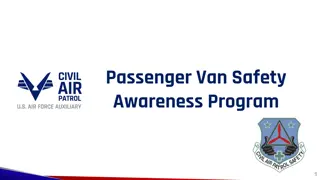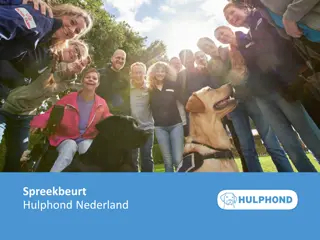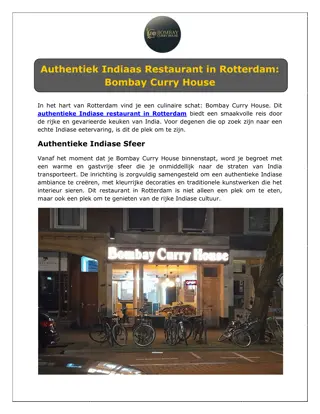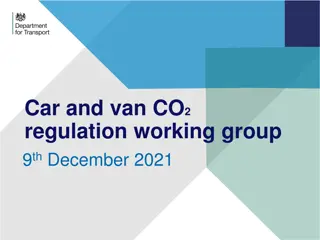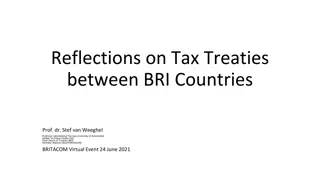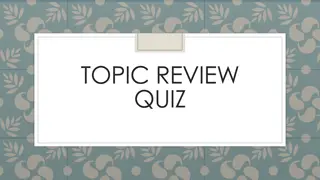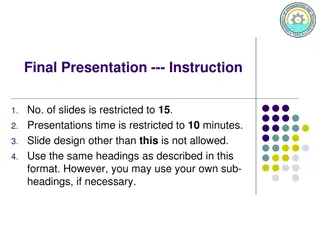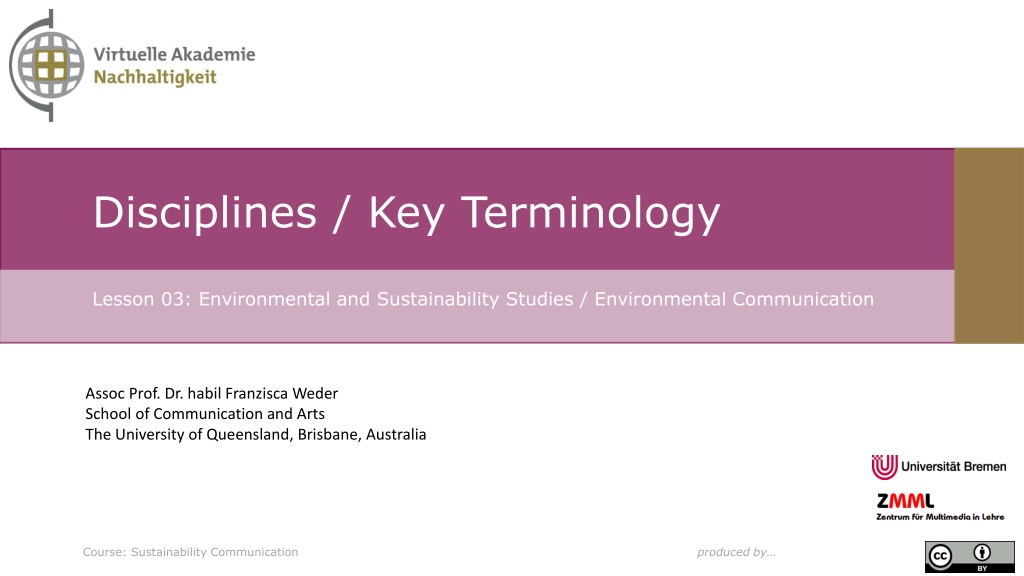
Key Terminology in Sustainability Communication
Explore the diverse field of sustainability communication, encompassing practices on individual, organizational, and societal levels. Gain insights into communication theories, strategies, and ethical standards, preparing you to address current global challenges and drive social change.
Download Presentation

Please find below an Image/Link to download the presentation.
The content on the website is provided AS IS for your information and personal use only. It may not be sold, licensed, or shared on other websites without obtaining consent from the author. Download presentation by click this link. If you encounter any issues during the download, it is possible that the publisher has removed the file from their server.
E N D
Presentation Transcript
Disciplines / Key Terminology Lesson 03: Environmental and Sustainability Studies / Environmental Communication Assoc Prof. Dr. habil Franzisca Weder School of Communication and Arts The University of Queensland, Brisbane, Australia Course: Sustainability Communication produced by
Sustainability Communication Disciplines and key terminology Lesson 03: Environmental and Sustainability Studies / Environmental Communication Where are we? Episode 1: Phenomena & key terminology Episode 2: Science Communication / Climate Change Comm. Episode 3: Environmental and Sustainability Studies / Environmental Communication Episode 4: CSR / CSR Communication Science & Risk Communication Sustainability Communication Environmental and Social Change Communication Strategic / CSR Communication
Sustainability Communication Disciplines and key terminology Lesson 03: Environmental and Sustainability Studies / Environmental Communication Learning outcomes Learning outcome 1: Describe the diverse nature of contemporary practices of sustainability communication on an individual, organizational and societal level, the relationship of strategic communication practices to other public communication practices, the role of stakeholders and publics and the communication practitioners in and outside of organizations (corporate, NGO, political and educational institutions etc.) Learning outcome 2: Develop comprehensive and well-founded knowledge in sustainability communication as field of study, an understanding of how other disciplines relate to the field and an international perspective on the field. Learning outcome 3: Understand the key elements of communication theories, strategies and tactics, and, thus, the character and operationalization of best practice sustainability communication planning frameworks. Learning outcome 4: Advance your understanding of social and civic responsibility and develop an appreciation of the philosophical and social context of sustainability communication. Advance your knowledge and respect of ethics and ethical standards in relation to communication of, about and for sustainability. Learning outcome 5: Anticipate and Interpret current issues and challenges of a world in transformation and social change. Develop a deep understanding of and skills to create change, develop advocacy, leadership and authorship in and for sustainability communication.
Sustainability Communication Disciplines and key terminology Lesson 03: Environmental and Sustainability Studies / Environmental Communication Recap Climate change communication is about educating, informing, warning, persuading, mobilizing and solving a very critical problem / risk Deeper level: climate change communication is shaped by our different experiences, mental and cultural models, and underlying values and worldviews Science / CC Comm: Communication about & of climate change Communication for change?
Sustainability Communication Disciplines and key terminology Lesson 03: Environmental and Sustainability Studies / Environmental Communication Overview A. Sustainability Studies B. Environmental Studies C. Environmental Communication
Sustainability Communication Disciplines and key terminology Lesson 03: Environmental and Sustainability Studies / Environmental Communication A. Sustainability Studies Sustainability research: paradigm shift within science Focus: Human-environment relationships Research as integrated approcah to cooperative problem-solving (Godemann & Michelsen, 2011: 5).
Sustainability Communication Disciplines and key terminology Lesson 03: Environmental and Sustainability Studies / Environmental Communication A. Sustainability Studies Inter- & transdisciplinary research new questions are needed, even awkward ones; new modes of knowledge production; problem-oriented research instead of traditional science practices; answers needed to the questions of today s complex society interests of social, economic and political actors are constitutive elements of the research process, expanding awareness of the problem and its potential solutions (Hirsch Hadorn et al., 2008); research needs to be embedded in cultural perception & action / cultural context; engagement and individual participation needed.
Sustainability Communication Disciplines and key terminology Lesson 03: Environmental and Sustainability Studies / Environmental Communication B. Environmental Studies Broad, multidisciplinary academic field Focus: human interactions with the environment, human-nature relationships Includes both, the natural environment (and animals) and the built environment and the relationship between them
Sustainability Communication Disciplines and key terminology Lesson 03: Environmental and Sustainability Studies / Environmental Communication B. Environmental Studies Key issues (from sustainability perspective) biodiversity, land and water sustainability, renewable energy, energy conservation, carbon capture and emission management, sustainable building design, urban planning, public health and well-being, economic development, triple bottom line analysis, and environmental, national and international treaty law.
Sustainability Communication Disciplines and key terminology Lesson 03: Environmental and Sustainability Studies / Environmental Communication B. Environmental Studies Nature has no voice Source: Photo by Dustan Woodhouse on Unsplash
Sustainability Communication Disciplines and key terminology Lesson 03: Environmental and Sustainability Studies / Environmental Communication B. Environmental Studies Nature has no voice Media We need to consider: Society Environment And ... the Public sphere: the sphere of influence created when different individuals engage each other in communication through conversation, argument, debate, and questions about subjects of shared concern or that affect a wider community (Cox, 2013, p. 6)
Sustainability Communication Disciplines and key terminology Lesson 03: Environmental and Sustainability Studies / Environmental Communication C. Environmental Communication 1970 (USA, Europe): news media framing of the environment & how the public understands and responds to environmental issues (Hansen & Cox, 2015) Establishment in USA particularly among rhetorical scholars (Cantrill & Oravec, 1996): how humans make sense of nature and environmental problems Today: Critical, constructivist, interpretative approach is still a strong foundation of current research (Takahashi et al., 2021) Increasing relevance of communication research in the face of potentially catastrophic issues (CC) -> establishment of the discipline/institutionalization (w. journals, departments, positions etc.) Handbooks: Hansen & Cox, 2015; Takahashi et al, 2021
Sustainability Communication Disciplines and key terminology Lesson 03: Environmental and Sustainability Studies / Environmental Communication C. Environmental Communication Dominant research agendas public communication about ecological problems as well as the related challenges for society; dissemination of information and implementation of communication practices that are related to the environment; research field that includes research and practices regarding how different actors (e.g., institutions, states, people) interact with regard to topics related to the environment and how cultural products influence society toward environmental issues; human interactions with nature and the environment (interpersonal communication, participatory decision-making, environmental media coverage); application of communication approaches, principles, strategies, and techniques to environmental management and protection; well researched issues: climate change, energy communication, representations of nature in the media, food & consumption studies
Sustainability Communication Disciplines and key terminology Lesson 03: Environmental and Sustainability Studies / Environmental Communication C. Climate Change Communication Perspective on Sustainability (Science / CC Comm): Sustainability as counter narrative (solution?) to climate change
Sustainability Communication Disciplines and key terminology Lesson 03: Environmental and Sustainability Studies / Environmental Communication C. Environmental Communication Perspective on Sustainability (Environmental Comm) Sustainability as (moral) principle of change Sustainability as principle of restoration / regeneration
Sustainability Communication Disciplines and key terminology Lesson 03: Environmental and Sustainability Studies / Environmental Communication Outlook New fields: neuroscience, virtual reality EC research does not particularly reflected on increasing number of social movements what s the ethical duty of a scholar then? sustainability EC: Communication about environmental affairs Communication for change!
Sustainability Communication Disciplines and key terminology Lesson 03: Environmental and Sustainability Studies / Environmental Communication Reflection 1. Try to identify how the human-nature relationship is presented and framed in the media 2. What are the facets of the environmental issues that are being discussed? 1. Why are some emphasized over others? 2. What are the implications? 3. How are people communicating? 1. Why are they using certain words, metaphors, visuals, frames, music, art, narratives, and other rhetorical devices? 2. Why not different words, etc.? 3. What are the consequence for those who hear and see these messages? 4. How should people be communicating?




